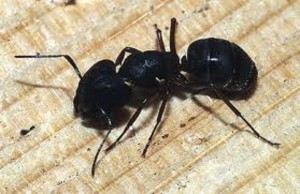Carpenter ants Nests are often concealed in wall voids, ceilings, subfloors, attics, or hollow doors. It is usually necessary for a professional pest control applicator to drill small (about 1/8 inch) holes and apply an insecticidal dust into the nest area. It is best to determine the nest’s location as specifically as possible. Control should not be applied randomly through the home. There are no insecticides available to the public that are labeled for this type of application.
If it is difficult to locate the nest, an insecticidal dust can be applied into wall voids through electrical outlets. Carpenter ants commonly travel along electrical wiring and are likely to encounter the insecticides. This method works more slowly than a direct treatment into the nest. Boric acid is available to home dwellers to treat wall voids through electrical outlets. CAUTION: Use extreme care around electrical wiring and take all necessary steps to avoid accidental electric shocks.
If the nest is exposed (e.g. due to remodeling or reroofing) you can use a liquid or aerosol ready-to-use insecticide, such as bifenthrin, cyfluthrin, deltamethrin, or permethrin. Spray the insecticide directly into as much of the nest as possible. The more of the colony that is exposed, the better your chance of destroying it. It is necessary to anticipate a carpenter ant colony and have a product ready at the start of construction. Once the nest is exposed, that portion of the colony will try to relocate to protect themselves.
Sprays on surfaces where ants travel or congregate, such as along baseboards or in holes or cracks in the walls and floors, may reduce the frequency and number of ants you see. However, they are not effective in eliminating a nest because 1) the ants carry very little insecticide back to their nests and 2) most ants forage outside and do not come in contact with the insecticides.
Be aware of the potential for more than one nest in a building, but only treat nests that you know exist. Do not treat areas of a building if additional nests are not found. Once a carpenter ant nest is treated, continue to watch for evidence of an active nest until the following spring. If no evidence is observed, then further insecticide applications are unnecessary.
